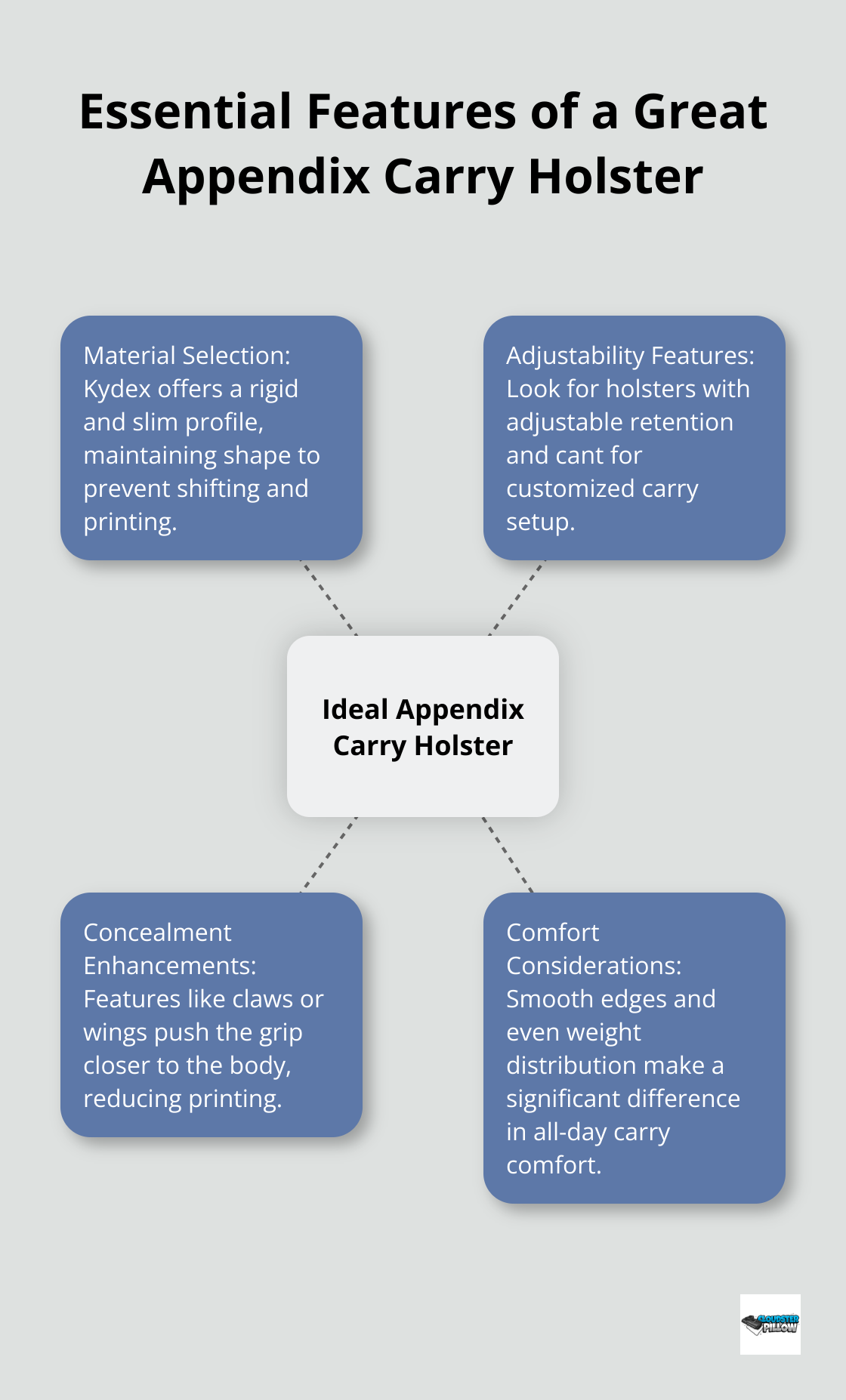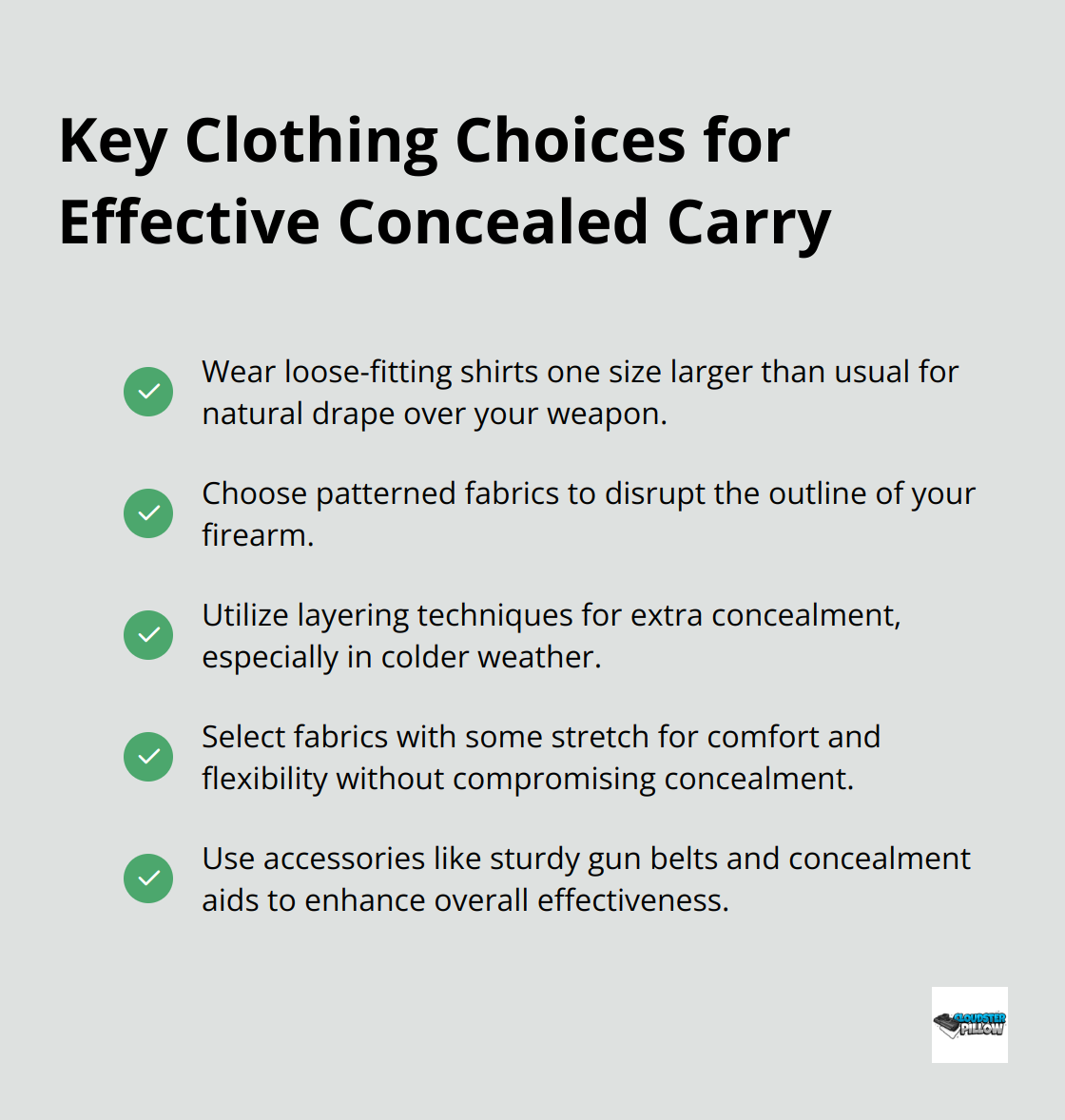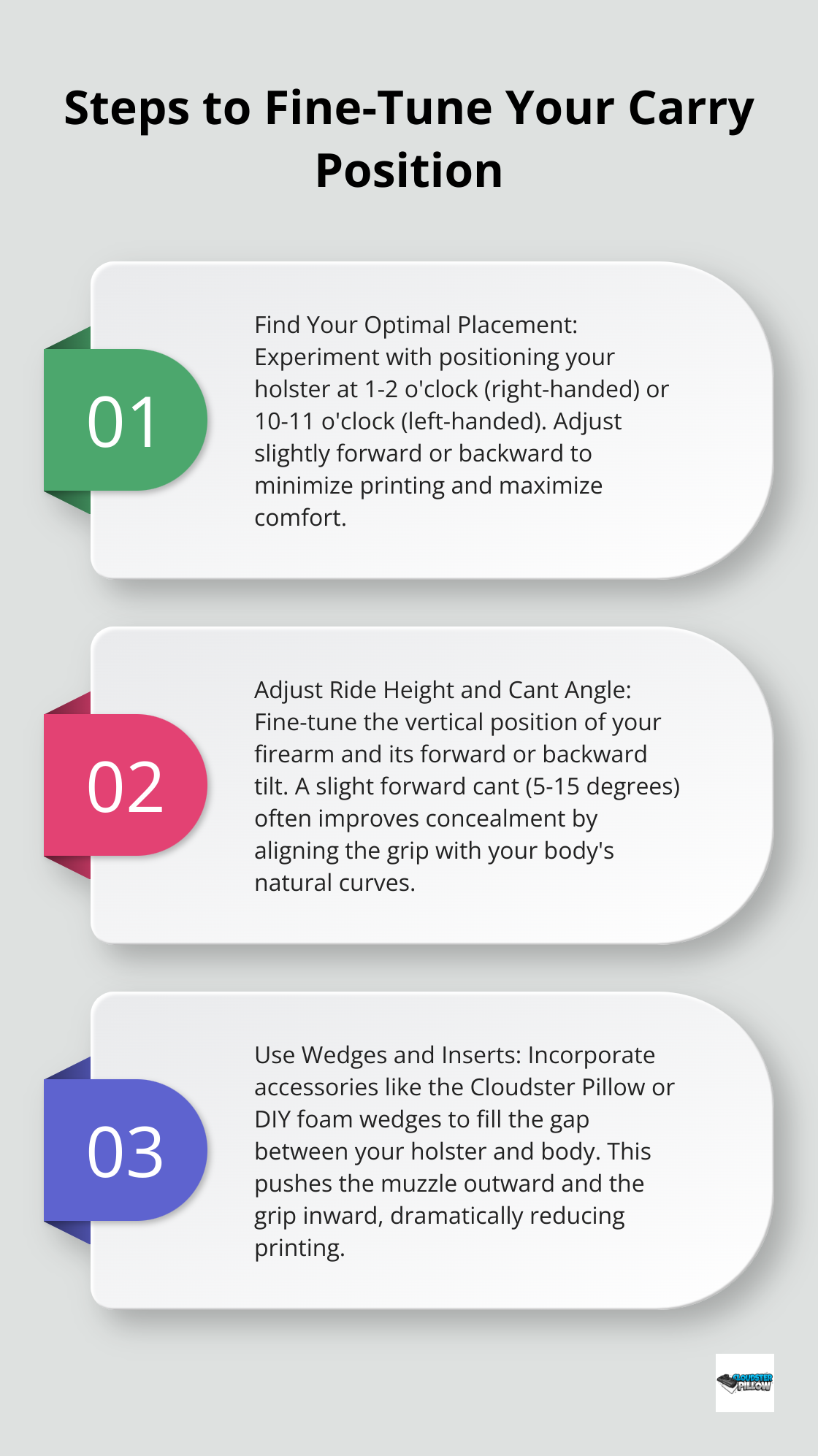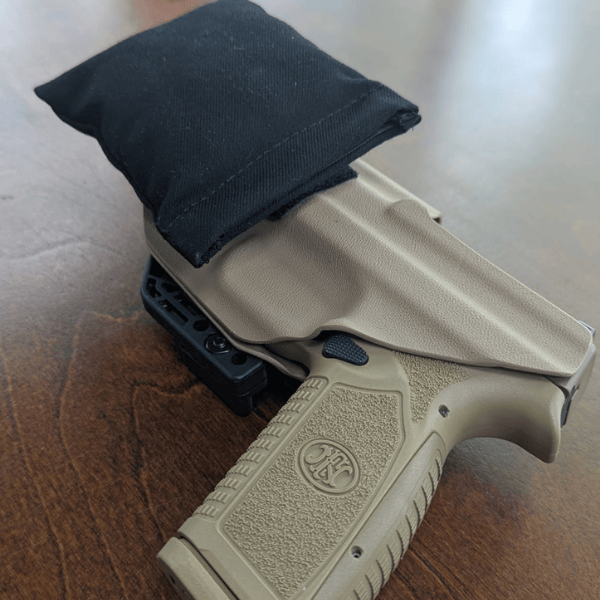Appendix Carry
How Can I Stop My Gun from Printing Through My Shirt When I Appendix Carry?
At Cloudster Pillow, we understand the importance of comfortable and effective concealed carry. Printing can be a major concern for those who practice appendix carry.
This guide will explore practical strategies to minimize printing, focusing on holster selection, clothing choices, and carry techniques. We’ll provide actionable tips to help you achieve a more discreet and comfortable concealed carry setup.
What Makes a Great Appendix Carry Holster?
Material Selection
The holster’s material significantly impacts concealment. Kydex offers a rigid and slim profile. It maintains its shape, which prevents the firearm from shifting and potentially printing. Leather holsters provide comfort but may not offer the same level of concealment due to their tendency to soften and conform to the body over time.
Adjustability Features
A top-notch appendix carry holster should offer adjustable retention and cant. Retention keeps your firearm secure, while adjustable cant allows you to fine-tune the angle of your weapon for optimal concealment and draw. Look for holsters with multiple adjustment points to customize your carry setup.
Concealment Enhancements
Some holsters include built-in features to aid in concealment. A claw or wing attachment pushes the grip of your firearm closer to your body, which reduces the likelihood of printing. A wedge at the bottom of the holster can help tilt the muzzle away from your body, further minimizing the gun’s profile.
Comfort Considerations
Concealment is paramount, but comfort shouldn’t take a back seat. A holster with smooth edges and a design that distributes weight evenly can make a significant difference in all-day carry comfort. Some users find that adding a foam wedge or using a product like the Cloudster Pillow enhances both comfort and concealment by filling the gap between the holster and body.
Finding Your Perfect Fit
The perfect holster often requires some trial and error. What works for one person may not work for another due to differences in body type, firearm choice, and personal preferences. Don’t hesitate to experiment with different holsters until you find the one that offers the best balance of concealment, comfort, and accessibility for your needs.

Now that we’ve covered the essentials of a great appendix carry holster, let’s move on to another critical aspect of minimizing printing: your clothing choices.
What to Wear for Concealed Carry
Loose-Fitting Shirts: Your Primary Concealment Strategy
Loose-fitting shirts serve as the foundation of concealed carry attire. These garments provide sufficient coverage for your firearm without drawing unwanted attention. Select shirts one size larger than your usual fit. The extra fabric creates a natural drape over your weapon, which minimizes visible outlines.
Appendix carry is optimum as you can reach your firearm in almost any position, but 4 O’clock is another solid option.
For warm weather, choose t-shirts with a looser cut around the midsection. In cooler climates, untucked button-up shirts offer excellent concealment. The key lies in selecting shirts that don’t cling to your body, especially around the waistline where your firearm rests.
Patterns: Your Concealment Ally
While solid colors have their place, patterned fabrics excel at concealment. Plaids, checks, and complex designs disrupt the outline of your firearm, making it harder to detect any unusual shapes. Hawaiian shirts (despite their bold appearance) prove surprisingly effective for concealment due to their busy patterns and loose fit.
Avoid tight or thin fabrics, as they reveal more than they conceal. Instead, opt for medium-weight fabrics that maintain their shape throughout the day.
Layering: A Powerful Concealment Technique
Layering isn’t just a fashion choice; it’s a potent tool for concealed carry. A light jacket or open button-up shirt over a t-shirt provides an extra layer of concealment. This technique works particularly well for larger firearms or when carrying in colder weather.
Appendix/AIWB carry is a safe means to concealed carry that places the gun near the abdomen for quicker access.
When layering, consider using a concealment aid (such as the Cloudster Pillow) as an additional measure. Its adjustable foam can help smooth out any telltale bulges, working in tandem with your clothing layers to create a more natural silhouette.
Fabric Selection: Balancing Comfort and Concealment
The right fabric choice can make a significant difference in your concealed carry comfort and effectiveness. Natural fibers like cotton offer breathability and comfort, while synthetic blends can provide durability and wrinkle resistance.
Try fabrics with some stretch (like cotton-spandex blends) for a comfortable fit that moves with you. These materials offer flexibility without compromising on concealment.
Accessorizing for Enhanced Concealment
Accessories can play a crucial role in your concealed carry wardrobe. A sturdy gun belt (designed specifically for concealed carry) helps distribute the weight of your firearm evenly, reducing fatigue and improving concealment.
A holster claw or “wing” can do wonders in aiding in concealment and comfort. These pieces attach to the holster and help press the grip of the gun closer to the body.
Consider vests or jackets with built-in concealed carry pockets for added versatility. These garments offer quick access to your firearm while maintaining a discreet appearance.

Your clothing choices significantly impact your ability to carry concealed effectively. The next section will explore how to adjust your carry position and technique for optimal concealment and comfort.
How to Fine-Tune Your Carry Position
Find Your Optimal Placement
Every body type requires a unique carry position. Start by positioning your holster at 1-2 o’clock (right-handed) or 10-11 o’clock (left-handed). Move it slightly forward or backward until you minimize printing and maximize comfort. This process demands patience and experimentation.
Adjust Ride Height and Cant Angle
Ride height affects concealment and draw speed. A higher ride keeps the gun closer to your body but may slow your draw. A lower ride speeds up access but could increase printing. Most holsters offer adjustable ride height – start at the middle setting and adjust from there.
Cant angle refers to the forward or backward tilt of your firearm. A slight forward cant (5-15 degrees) often improves concealment by aligning the grip with your body’s natural curves. Some users prefer a neutral cant for faster draws. Test different angles to determine what works best for you.
Use Wedges and Inserts
Wedges and foam inserts transform appendix carry. These accessories fill the gap between your holster and body, pushing the muzzle outward and the grip inward. This subtle adjustment can dramatically reduce printing.
For a more effective and reliable solution, our Holster Wedge is specifically designed to do this job better than a simple DIY foam piece. The Holster Wedge attaches securely to all appendix carry holsters, providing ergonomic padding that distributes pressure evenly while angling the firearm for tighter concealment. It stays in place throughout the day and makes extended carry noticeably more comfortable.
The Cloudster Pillow can enhance both comfort and concealment. Many users report significant improvements when using this versatile accessory.
For a DIY approach, cut a simple foam wedge from a yoga block. Attach it to the bottom of your holster with strong adhesive or hook-and-loop fasteners. Start with a small wedge and increase size as needed for optimal concealment.
Experiment and Refine
Finding your perfect carry setup takes time. What works for others may not work for you. Dedicate time to experiment with different combinations of holsters, belts, and clothing to find your perfect setup. Your patience will pay off as you discover a configuration that offers both comfort and effective concealment.

FAQs
1. How can I stop my gun from printing through my shirt when carrying appendix?
To minimize printing when carrying appendix, consider selecting a high-quality holster made of materials like Kydex for a slim profile. Holsters with adjustable retention and cant allow for customization, which can further reduce printing. Additionally, using concealment features like holster claws or wedges, as well as adjusting your clothing choices, can help minimize printing significantly.
2. What type of holster is best for appendix carry to reduce printing?
A great appendix carry holster should be made of a rigid material, like Kydex, to ensure the firearm remains in place and does not shift. The holster should also feature adjustable retention and cant, allowing for fine-tuning of the angle and security. Adding concealment enhancements like a holster claw or wedge can help reduce printing and improve overall comfort.
3. How does clothing choice affect printing when carrying appendix?
Loose-fitting shirts, particularly those one size larger than your normal fit, are key to concealing your firearm without printing. Patterns, such as plaids or checks, are excellent at breaking up the outline of your firearm. Avoid tight, thin fabrics and consider layering, such as wearing a light jacket or open shirt over a t-shirt, to further conceal your firearm.
4. How can I adjust my carry position to reduce printing when appendix carrying?
Experimenting with the position of your holster is crucial. Start by positioning it at 1-2 o’clock (right-handed) or 10-11 o’clock (left-handed) and adjust until printing is minimized. You can also adjust the ride height (higher or lower) and the cant angle (slightly forward or neutral) to further reduce printing and improve comfort.
5. Can a wedge or insert help with printing when carrying appendix?
Yes, using a wedge or insert can significantly reduce printing when appendix carrying. These accessories fill the gap between your holster and body, which helps angle the firearm in a way that minimizes the profile. The Cloudster Pillow, for example, offers enhanced comfort and concealment by pushing the grip closer to your body and reducing pressure points.
Final Thoughts
Mastering concealed carry requires the right gear, clothing, and techniques. A quality holster with adjustability features forms the foundation for effective appendix carry. Loose-fitting, patterned shirts play a crucial role in minimizing printing. You must fine-tune your carry position, including ride height and cant angle, to enhance discreet carry.
Finding your ideal setup demands experimentation and refinement. Your body type, lifestyle, and preferences will influence the best solution for you. Comfort and concealment should be your top priorities when perfecting your concealed carry setup. The Cloudster Pillow can significantly reduce printing while improving comfort.
Effective concealed carry transcends gear selection. It involves developing skills and habits for safe, discreet carry in various situations. Regular practice with your chosen setup will increase your proficiency and comfort. Your goal is to blend seamlessly into daily life while maintaining readiness to protect yourself and others if necessary.


Pingback: Concealed Carry Printing: How to Stop It and Carry Confidently